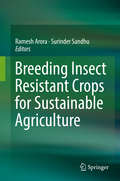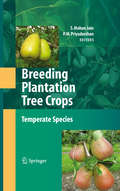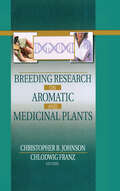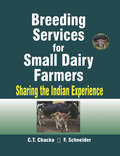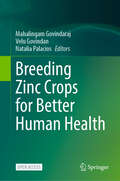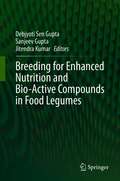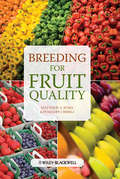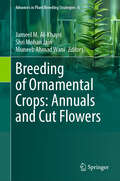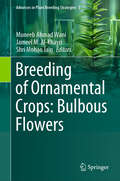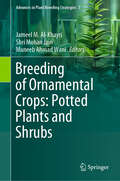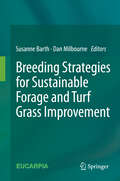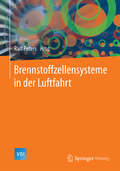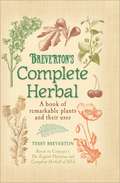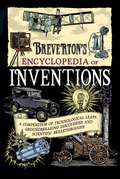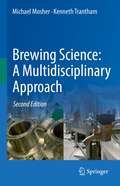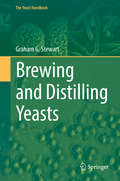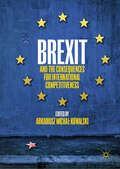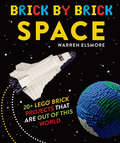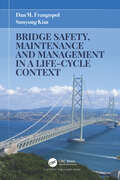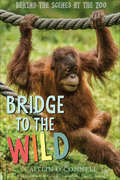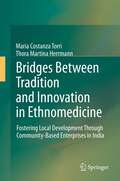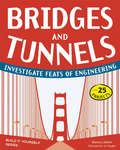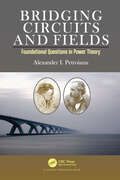- Table View
- List View
Breeding Insect Resistant Crops for Sustainable Agriculture
by Ramesh Arora Surinder SandhuThis book reviews and synthesizes the recent advances in exploiting host plant resistance to insects, highlighting the role of molecular techniques in breeding insect resistant crops. It also provides an overview of the fascinating field of insect-plant relationships, which is fundamental to the study of host-plant resistance to insects. Further, it discusses the conventional and molecular techniques utilized/useful in breeding for resistance to insect-pests including back-cross breeding, modified population improvement methods for insect resistance, marker-assisted backcrossing to expedite the breeding process, identification and validation of new insect-resistance genes and their potential for utilization, genomics, metabolomics, transgenesis and RNAi. Lastly, it analyzes the successes, limitations and prospects for the development of insect-resistant cultivars of rice, maize, sorghum and millet, cotton, rapeseed, legumes and fruit crops, and highlights strategies for management of insect biotypes that limit the success and durability of insect-resistant cultivators in the field. Arthropod pests act as major constraints in the agro-ecosystem. It has been estimated that arthropod pests may be destroying around one-fifth of the global agricultural production/potential production every year. Further, the losses are considerably higher in the developing tropics of Asia and Africa, which are already battling severe food shortage. Integrated pest management (IPM) has emerged as the dominant paradigm for minimizing damage by the insects and non-insect pests over the last 50 years. Pest resistant cultivars represent one of the most environmentally benign, economically viable and ecologically sustainable options for utilization in IPM programs. Hundreds of insect-resistant cultivars of rice, wheat, maize, sorghum, cotton, sugarcane and other crops have been developed worldwide and are extensively grown for increasing and/or stabilizing crop productivity. The annual economic value of arthropod resistance genes developed in global agriculture has been estimated to be greater than US$ 2 billion Despite the impressive achievements and even greater potential in minimizing pest- related losses, only a handful of books have been published on the topic of host-plant resistance to insects. This book fills this wide gap in the literature on breeding insect- resistant crops. It is aimed at plant breeders, entomologists, plant biotechnologists and IPM experts, as well as those working on sustainable agriculture and food security.
Breeding Plantation Tree Crops: Temperate Species
by P. M. Priyadarshan Shri Mohan JainTree species are indispensable to human needs. Due to their long life cycle and environmental sensitivity, breeding trees for sustainable production is a formidable challenge in order to meet the demands of growing human population and industries. Fruit crops such as apple, cocoa, mango, citrus, litchi, pear, dates, and coconut or industrial crops including rubber and tea, improving yield under the optimal, sub-optimal and marginal areas call for a unified worldwide effort. While the uniqueness of coconut as 'kalpavriksha' (Sanskrit - meaning tree of life) makes its presence in every continent from Far East to South America, tree crops such as cocoa, oil palm, rubber, apple, peach and walnut prove their environmental sensitivity towards tropical, subtropical and temperate climates. Date palm is quintessential for desert climate. Thus, from soft drinks to breweries to oil to tires, the value addition offers a spectrum of products to human kind, enriched with nutritional, environmental, financial, and trade related attributes. This volume is a compilation of information on breeding of temperate tree species and provides first hand comprehensive knowledge to research, teach, and make policies.
Breeding Research on Aromatic and Medicinal Plants
by Christopher B Johnson Chlodwig FranzThe field of medicinal/aromatic plant breeding is growing and changing?this resource will help you stay up to date! In this essential book, researchers from large and small laboratories and institutions throughout Europe and the Mediterranean region explore recent developments in the selection and breeding of aromatic and medicinal plants. They take varied approaches?from traditional breeding to the use of molecular markers?and complement them with up-to-date information on biodiversity and resource conservation. From the editors: ?It is widely recognized that a strategy of `conservation through use,? by which plant collection via wild harvesting is replaced by controlled cultivation, is the best way forward if we are to balance human demands with the necessary conservation of the biodiversity represented by these species. That provides one major driving force for research in this field. Another concerns the very real need for improving the quality control of products on the market, both to satisfy consumer demand and to conform with the (justifiably) increasing requirements for standardization and precise identification of the composition of the plant materials being sold for human use. We hope that this volume will give readers a taste of the exciting developments in the field.? Breeding Research on Aromatic and Medicinal Plants examines: breeding for resistance and abiotic factors manipulating natural product accumulation through genetic engineering biochemical and molecular regulation of essential oil accumulation economic and legal considerations that breeders will encounter the ethical aspects of breeding these plants
Breeding Services for Small Dairy Farmers: Sharing the Indian Experience
by C T ChackoBetter validation of indigenous domestic animal genetic resources is becoming more important with regard to the potential of livestock for poverty alleviation and income generation. To improve indigenous breeds for sustainable income and employment generation, the methods to be employed are the same as developed in systematic breeding programs, be it for cross-breeding or selective breeding within a specific breed. This book systematically introduces the reader to the breed improvement theory and illustrates the theory with practical examples and case studies. The book is addressed to animal science teachers, to undergraduate and postgraduate students as well as to decision makers in the state and central livestock departments.
Breeding Zinc Crops for Better Human Health
by Mahalingam Govindaraj Velu Govindan Natalia PalaciosThis open access book discusses Micronutrient Malnutrition (MM) is a major obstacle to the development of human resources in developing nations in Asia and Africa and has been identified as a public health concern. Globally, more than 2 billion people suffer from MM. The most susceptible groups are women and young children under five. The main cause of the persistence of MM prevalence is the inaccessibility, unavailability, or high cost of diets rich in zinc. Typically, staple foods are poor in minerals. An inadequate intake of zinc (Zn) compromises human nutrition and immunological function. Breeding staple crops with enhanced critical nutrients offers a long-term solution for populations dependent on single staples or diets with less diversity. The significance of zinc in human nutrition, high throughput zinc phenotyping techniques, breeding product profile design, new varieties and germplasm that are rich in zinc, and the genetics and genomics of zinc are all covered in this book. For the first time, the publicly available standards (PAS) under the BSI standards for zinc crops were reviewed with an eye toward future global commercial production and commercialization. This edited volume will function as a scientific knowledge base and reference for researchers, graduate students, and other professionals in a comparable field. The goal is to enable biofortification science to help the poor world achieve food and nutrition security.
Breeding for Enhanced Nutrition and Bio-Active Compounds in Food Legumes
by Sanjeev Gupta Jitendra Kumar Debjyoti Sen GuptaMore than 20 million childhood deaths occur every year due to the micronutrient deficiency and diet-related non-communicable diseases (cardiovascular diseases, cancers, chronic respiratory diseases and diabetes). The United Nations (UN) recently announced that the increase in chronic, non-communicable diseases has resulted in 36 million deaths around the world annually, claiming more lives than all other causes combined. These chronic diseases are not isolated to developed countries and are even more pronounced in the developing world. Such chronic illnesses have caused far more deaths than infectious diseases throughout the world (except Africa) in recent years. Therefore, enrichment of micronutrients in staple food crops is of paramount importance for the nutritional security in our world. Biofortification is the development of micronutrient- and/or vitamin-rich crops using traditional crop improvement practices as well as modern biotechnology tools. It is a more sustainable and cost effective method than food supplementation, fortification and diet diversification. This work consolidates available information on the different aspects of breeding for improved nutrition of pulses. An overview of entire pulses based on their nutritional profile is given so that audience can find the desired information easily. Food legumes are the active ingredients in many gluten-free food products and there is a continuous rise of the use of pulses flour in milling and baking processes. Our book sheds light on recent efforts and the underlying constraints of meeting the public demand. We believe this work provides the basic information for anyone interested in biofortification and stimulate further research to meet this unique challenge.
Breeding for Fruit Quality
by Matthew A. Jenks Penelope J. BebeliThe global demand for high quality fruits that are rich in nutrients and that can endure the demands of worldwide supply chains is growing rapidly. Fruits are an important component of the human diet, providing vitamins, minerals, antioxidants, and fiber. All of these qualities contribute to the nutritional needs and health maintenance of humans. Breeding for Fruit Quality reviews the application of modern plant breeding methods to the development of improved varieties of fruits. Breeding for Fruit Quality opens with chapters that look at fruit biology and breeding strategies behind specific traits, including a look at traits such as organoleptic quality, nutritional value, and improved yield, among others. Subsequent chapters review breeding efforts to improve overall quality in a wide range of specific fruits. Providing broad ranging coverage of cutting edge methods now being applied to the development of fruit crops, Breeding for Fruit Quality will be a valuable resource for fruit biologists, breeders, geneticists, and industry personnel. Key Features: Broad coverage of modern breeding technologies being implemented to improve overall fruit quality Trait specific chapters explore efforts to promote traits of industrial and nutritional importance Chapters in fruits, ranging from apple and grapes to tomatoes and olives, provide detailed coverage of breeding practices for economically important fruit crops
Breeding of Ornamental Crops: Annuals and Cut Flowers (Advances in Plant Breeding Strategies #6)
by Shri Mohan Jain Jameel M. Al-Khayri Muneeb Ahmad WaniFlowers and other ornamental plants are used for all occasions to meet consumers demands preferably novel flowers traits, e.g., fragrance, flower color and shape, early flowering, less water consumption, long shelf-life. The worldwide floricultural industry is worth over 50 billion Euros and can serve as a ‘food security’, socio-economic impact, and generate employment. Ornamental industry is regarded as one of the fastest growing farm industries. This industry is sustained through novelty, thus there is increasing demand on plant breeders in both public and private sectors to fulfil consumer’s needs. Biotechnological approaches such as genetic transformation, genomics, nanotechnology, and gene editing are well suited for designing custom-made novel traits of flowers benefiting both ornamental and cosmetic industry. Moreover, micropropagation is well exploited commercially for large-scale plant production along with vertical and digital farming, and artificial intelligence especially by the floriculture industry. This book focuses on advances in breeding strategies of diverse range of ornamental plants. It consists of 2 parts, Part I Flowering annuals and Part II Cut flowers. Each chapter, contributed by eminent authors, is devoted to an individual ornamental species or a group of related species. It provides an in depth understanding of modern breeding strategies including traditional methods and biotechnological approaches. Topics covered in each chapter, in relation to the subject species, include current cultivation practices and challenges, germplasm biodiversity and conservation, traditional breeding, molecular breeding, tissue culture applications, genetic engineering and gene editing, mutation breeding, hybridization, and future research directions. Major concepts are illustrated with color photos.
Breeding of Ornamental Crops: Bulbous Flowers (Advances in Plant Breeding Strategies #5)
by Shri Mohan Jain Jameel M. Al-Khayri Muneeb Ahmad WaniFlowers and other ornamental plants are used for all social occasions. Consumers' preferences dictate the development of novel flower traits such as fragrance, flower color and shape, early flowering, less water consumption, and long shelf-life. The worldwide floricultural industry is worth over 50 billion Euros and can serve as a component of food security, influence socio-economic development, and generate employment. The ornamental industry is regarded as one of the fastest-growing farm industries. This industry is sustained through novelty, thus there is an increasing demand for plant breeders in both public and private sectors to fulfill consumers’ needs. Biotechnological approaches such as genetic transformation, genomics, nanobiotechnology, and gene editing are well suited for designing custom-made novel traits of flowers benefiting both the ornamental and cosmetic industries. Moreover, micropropagation is well exploited commercially for large-scale plant production along with vertical and digital farming, and artificial intelligence, especially by the floriculture industry. This book focuses on advances in breeding strategies of bulbous flower ornamental plants. Each chapter, contributed by eminent authors, is devoted to an individual ornamental species or a group of related species. It provides an in-depth understanding of modern breeding strategies including traditional methods and biotechnological approaches. Topics covered in each chapter, in relation to the subject species, include current cultivation practices and challenges, germplasm biodiversity and conservation, traditional breeding, molecular breeding, tissue culture applications, genetic engineering and gene editing, mutation breeding, hybridization, and future research directions. Major concepts are illustrated with color photos.
Breeding of Ornamental Crops: Potted Plants and Shrubs (Advances in Plant Breeding Strategies #7)
by Shri Mohan Jain Jameel M. Al-Khayri Muneeb Ahmad WaniFlowers and other ornamental plants are used for all occasions to meet consumers demands preferably novel flowers traits, e.g., fragrance, flower color and shape, early flowering, less water consumption, long shelf-life. The worldwide floricultural industry is worth over 50 billion Euros and can serve as a ‘food security’, socio-economic impact, and generate employment. Ornamental industry is regarded as one of the fastest growing farm industries. This industry is sustained through novelty, thus there is increasing demand on plant breeders in both public and private sectors to fulfil consumer’s needs. Biotechnological approaches such as genetic transformation, genomics, nanotechnology, and gene editing are well suited for designing custom-made novel traits of flowers benefiting both ornamental and cosmetic industry. Moreover, micropropagation is well exploited commercially for large-scale plant production along with vertical and digital farming, and artificial intelligence especially by the floriculture industry. This book focuses on advances in breeding strategies of diverse range of ornamental plants. It is composed of 2 parts, Part I Ornamental potted plants, and Part II Ornamental shrubs. Each chapter, contributed by eminent authors, is devoted to an individual ornamental species or a group of related species. It provides an in depth understanding of modern breeding strategies including traditional methods and biotechnological approaches. Topics covered in each chapter, in relation to the subject species, include current cultivation practices and challenges, germplasm biodiversity and conservation, traditional breeding, molecular breeding, tissue culture applications, genetic engineering and gene editing, mutation breeding, hybridization, and future research directions. Major concepts are illustrated with color photos.
Breeding strategies for sustainable forage and turf grass improvement
by Dan Milbourne Susanne BarthFrom the 4th - 8th of September 2011, the Eucarpia Fodder Crops and Amenity Grasses Section, held its 29th Meeting in the surroundings of Dublin Castle in Ireland. The theme of the meeting was 'Breeding strategies for sustainable forage and turf grass improvement'. Grasslands cover a significant proportion of the land mass of the world, and play a pivotal role in global food production. At the same time we are faced with several challenges that affect the way in which we think about this valuable set of resources. The population of the world is expected to exceed 9 billion by 2050, and increase of about one third relative to today's levels. This population increase will be focused in urban areas, and in what are currently viewed as "developing" countries, meaning that the buying power of this increased population will be greater - shifting the balance of demand from staple crops to high value items such as meat and dairy products. Overall that the world will have to approximately double agricultural output across all categories of food to meet the demands of this larger, urbanised population. This is occurring against a backdrop of equally large challenges in terms of global climate change. Agriculture is already a significant contributor to e.g. greenhouse gas emissions, deforestation and soil erosion. The situation is made more complex by an increased emphasis on biofuels as a solution for our imminent oil shortage, resulting in increased competition between land utilised for food and fuel. In short, agriculture must continue to feed the world, whilst not contributing to damaging it further. It must be sustainable. Plant breeding plays a significant but frequently understated role in meeting the challenges presented by this complex and changing scenario. However, plant breeding and improvement is itself undergoing radical change driven by technology. This book explores how forage and turf breeding is changing and adapting to meet these challenges using the technological advances being experienced in plant breeding as a whole.
Brennstoffzellensysteme in der Luftfahrt (VDI-Buch)
by Ralf PetersDer Einsatz von Brennstoffzellensystemen im Flugzeug bietet die M#65533;glichkeit, die Funktionen Strom, Wasser- und Inertgaserzeugung mit Hilfe eines einzigen Systems zu gew#65533;hrleisten, Hilfssysteme (Wassertanks, die konventionelle APU und das FTIS) k#65533;nnen ebenso entfallen wie die zus#65533;tzliche Speicherung von Wasser. Generatoren und Batterien k#65533;nnen kleiner dimensioniert werden. Diese Ma#65533;nahmen verringern den Kraftstoffverbrauch, erh#65533;hen die Gesamteffizienz eines Flugzeuges und erm#65533;glichen einen emissionsarmen Betrieb von Flugzeugen im Flug und besonders am Boden. Die Autoren vergleichen Aspekte bei der Nutzung heutiger und zuk#65533;nftiger Kraftstoffe f#65533;r Brennstoffzellen in der Luftfahrt. Die Eigenschaften geeigneter Brennstoffzellentypen werden beschrieben und analysiert, es wird dabei dargestellt warum der Brennstoffzellentyp HT-PEFC besonders geeignet ist und welche Herausforderungen damit verbunden sind. Technische Entwicklungen, wie die HT-PEFC Stackentwicklung, die der Komponenten des Brenngaserzeugungssystems und der Aufbau und der Test eines 5 kWe HT-PEFC Gesamtsystems werden beschrieben. Das Buch schlie#65533;t mit der Betrachtung von Brennstoffzellensystemen als Bestandteil eines multifunktionalen Systems und dem Ausblick auf zuk#65533;nftige Anwendungen in der Luftfahrttechnik.
Breverton's Complete Herbal
by Terry BrevertonBreverton's Complete Herbal is a modern reworking of Culpeper's classic reference guide, Culpeper's Complete Herbal. Arranged alphabetically, this book describes over 250 herbs and spices as well as feature entries on scented herb/medicinal gardens, the great herbalists and New World Herbs not included in Culpepper's original text. Each entry provides a description of the herb: its appearance and botanical features, a brief history of its uses in medicine, dyeing and cuisine to bizarre remedies and concoctions designed to get rid of all manner of real and imaginary ailments. As informative as it is entertaining, this incredibly diverse compendium contains just about everything you'll ever need to know about the properties and provenance of herbs and spices of the world. From amara dulcis to yarrow, all-heal to viper's bugloss, Breverton's Complete Herbal is a modern day treasury of over 250 herbs and their uses.
Breverton's Encyclopedia of Inventions
by Terry BrevertonInvention and innovation are what distinguish the human race from all of the other species on Earth. Throughout history the imagination and pioneering spirit of human kind has compelled us to question why we do things in a certain way and, more importantly, how we can do things better. Celebrating the ingenuity, creativity and resourcefulness that has led to some of the most amazing technological leaps through the ages, Breverton's Encyclopedia of Inventions examines the key innovations and breakthroughs of all time and the genius behind them.Starting with the building of the pyramids in ancient Egypt and the discovery of the solar system, moving through surgery, dynamite and rockets, to modern technology such as the smart card and genetic engineering, Terry Breverton springs many surprises. He uncovers fascinating and little-known facts: for example, that Price, not Fleming, discovered penicillin; that Swan, not Edison invented the electric light, and that Wallace, not Darwin first advanced the theory of evolution. Tracing the sheer persistence of brilliant men and women across the globe, who fought the prevailing ideas of their times and advanced technology, Breverton's Encyclopedia of Inventions will inspire anyone interested in the history and developments that have changed our lives and shaped our planet's future.
Brewing Science: A Multidisciplinary Approach
by Michael Mosher Kenneth TranthamThis updated text collects all the introductory aspects of beer brewing science into one place for undergraduate brewing science courses. This expansive and detailed work is written in conversational style, walking students through all the brewing basics from the origin and history of beer to the brewing process to post-brew packaging and quality control and assurance. As an introductory text, this book assumes the reader has no prior knowledge of brewing science and only limited experience with chemistry, biology and physics. The text provides students with all the necessary details of brewing science using a multidisciplinary approach, with a thorough and well-defined program of in-chapter and end-of-chapter problems. As students solve these problems, they will learn how scientists think about beer and brewing and develop a critical thinking approach to addressing concerns in brewing science. As a truly comprehensive introduction to brewing science, Brewing Science: A Multidisciplinary Approach, Second Edition walks students through the entire spectrum of the brewing process. The different styles of beer, the molecular makeup and physical parameters, and how those are modified to provide different flavors are listed. All aspects of the brewery process, from the different setup styles to sterility to the presentation of the final product, are outlined in full. All the important brewing steps and techniques are covered in meticulous detail, including malting, mashing, boiling, fermenting and conditioning. Bringing the brewing process full circle, this text covers packaging aspects for the final product as well, focusing on everything from packaging technology to quality control. Students are also pointed to the future, with coverage of emerging flavor profiles, styles and brewing methods. Each chapter in this textbook includes a sample of related laboratory exercises designed to develop a student’s capability to critically think about brewing science. These exercises assume that the student has limited or no previous experience in the laboratory. The tasks outlined explore key topics in each chapter based on typical analyses that may be performed in the brewery. Such exposure to the laboratory portion of a course of study will significantly aid those students interested in a career in brewing science.
Brewing and Distilling Yeasts (The Yeast Handbook)
by Graham G. StewartThis book is an overview considering yeast and fermentation. The similarities and differences between yeasts employed in brewing and distilling are reviewed. The implications of the differences during the production of beer and distilled products (potable and industrial) are discussed. This Handbook includes a review of relevant historical developments and achievements in this field, the basic yeast taxonomy and biology, as well as fundamental and practical aspects of yeast cropping (flocculation), handling, storage and propagation. Yeast stress, vitality and viability are also addressed together with flavor production, genetic manipulation, bioethanol formation and ethanol production by non-Saccharomyces yeasts and a Gram-negative bacterium. This information, and a detailed account of yeast research and its implications to both the brewing and distilling processes, is a useful resource to those engaged in fermentation, yeast and their many products and processes.
Brexit and the Consequences for International Competitiveness
by Arkadiusz Michał KowalskiThis book provides a study on the impact of Brexit on international competitiveness and in doing so, presents a theoretical account of regional disintegration. In recent decades, the theory of regional economic integration has expanded following growing integration processes taking place not only in Europe, but in other continents too. The result of the EU Referendum in the United Kingdom on 23 June 2016 revealed that regional integration does not have to be a one-way process as was perceived for many years. Despite well-developed models of economic integration within economic theory, there still lacks an analytical explanation of the mechanics of disintegration. For many years, integration was commonly perceived as a beneficial process, and while disintegration is not desirable, this led to normative bias in the research on regional integration. This book, therefore, makes an important contribution to theoretical and empirical developments of regional economic disintegration.
Brick by Brick Space: 20+ LEGO Brick Projects That Are Out of This World
by Warren ElsmoreFrom a master LEGO builder comes twenty easy-to-build space projects using nothing but LEGO bricks!What's better than space or building with LEGO bricks? Building amazing space projects out of your LEGO bricks, of course! Brick by Brick Space provides more than twenty-five amazing projects to build with your LEGO bricks. Follow the easy step-by-step instructions to create space stations, satellites, planets, rocket ships, and more. Scattered throughout are fun and fascinating facts about space exploration and the various objects that are orbiting our world. This is a must-have book for any space enthusiast or LEGO lover.
Bridge Safety, Maintenance and Management in a Life-Cycle Context
by Dan M. Frangopol Sunyong KimDuring the past two decades, it has been generally acknowledged that life-cycle bridge analysis can be a systematic tool to address efficient and effective bridge management under uncertainty life-cycle management at the bridge network level can lead to an improvement in the allocation of limited financial resources, ensuring the safety and functionality of the bridge network life-cycle management of bridges and bridge networks based on resilience and sustainability can improve their resistance and robustness to extreme events such as earthquakes, tsunamis, floods, and hurricanes bridge management should consider the impact of environmental conditions and climate change This book addresses important concepts and approaches developed recently on bridge safety, maintenance, and management in a life-cycle context. Bridge life-cycle performance and cost analysis, prediction, optimization, and decision making under uncertainty are discussed. The major topics include bridge safety and service life prediction; bridge inspection and structural health monitoring; bridge maintenance; life-cycle bridge and bridge network management; optimum life-cycle bridge management planning; resilience and sustainability of bridges and bridge networksunder hazards; and bridge management considering climate change. By providing practical applications of the presented concepts and approaches, this book can help students, researchers, practitioners, infrastructure owners and managers, and transportation officials to build up their knowledge of life-cycle bridge performance and cost management at bothproject level and network level under various deteriorating mechanisms, hazards and climate change effects.
Bridge to Freedom
by Isabel R. MarvinSynopsis: It is March 1945, the last days of World War II, just inside the German front. Kurt, a German army deserter, and Rachel, a 15-year-old Jew who has escaped from the terrors of Nazi Berlin, meet. The two must trust each other in order to survive and escape. For ages 10 and up.
Bridge to the Wild: Behind the Scenes at the Zoo
by Caitlin O'ConnellHear crisp sounds of the hornbill in the cool air. Listen to the morning symphony that greets you as you enter the front gate. Then, step onto a leafy path that leads to a secret world of animals, each of whom you won&’t want to forget, here at Zoo Atlanta. Over five days we meet a menagerie of magnificent animals—pandas, elephants, gorillas, meerkats, flamingos and more—alongside the longtime animal lover, scientist, and researcher Caitlin O&’Connell. With inside access to the guidance and knowledge of their beloved zoo caretakers and with stunning photographs, we are able to see the day-to-day marvels—and sometimes misfortunes—behind the animals&’ enclosures that often go unseen by the everyday zoo visitor. In this example of narrative nonfiction at its best, O&’Connell has created a bridge to wild, a rare chance to look beyond the zoo and to inspire guests to see for themselves just how special the animals we share our world with are.
Bridges
by Lori O'Dea Lesli FavorSingle title not for individual sale. Included in larger packages only
Bridges Between Tradition and Innovation in Ethnomedicine: Fostering Local Development Through Community-Based Enterprises in India
by Thora Martina Herrmann Maria Costanza TorriCommunity-based enterprises are the result of a process in which the community acts entrepreneurially to create and operate a new enterprise embedded in its existing social structure and network. This book argues that community-based enterprise could represent a strategy for fostering sustainable local development while at the same time maintaining traditional knowledge in ethnomedicine and conserving the local ecosystems.
Bridges and Tunnels
by Donna Latham Jenn VaughnBridges and tunnels are lifelines. People have tackled seemingly insurmountable obstacles, including vast canyons and mountain ranges, to design and construct these amazing passageways. Bridges and Tunnels: Investigate Feats of Engineering invites children ages 9 and up to explore the innovation and physical science behind structures our world depends on. Trivia and fun facts illustrate engineering ingenuity and achievements. Activities and projects encourage children to learn about the engineering process and to embrace trial and error.
Bridging Circuits and Fields: Foundational Questions in Power Theory
by Alexander I. PetroianuEnergy and power are fundamental concepts in electromagnetism and circuit theory, as well as in optics, signal processing, power engineering, electrical machines, and power electronics. However, in crossing the disciplinary borders, we encounter understanding difficulties due to (1) the many possible mathematical representations of the same physical objects, and (2) the many possible physical interpretations of the same mathematical entities. The monograph proposes a quantum and a relativistic approach to electromagnetic power theory that is based on recent advances in physics and mathematics. The book takes a fresh look at old debates related to the significance of the Poynting theorem and the interpretation of reactive power. Reformulated in the mathematical language of geometric algebra, the new expression of electromagnetic power reflects the laws of conservation of energy-momentum in fields and circuits. The monograph offers a mathematically consistent and a physically coherent interpretation of the power concept and of the mechanism of power transmission at the subatomic (mesoscopic) level. The monograph proves (paraphrasing Heaviside) that there is no finality in the development of a vibrant discipline: power theory.
